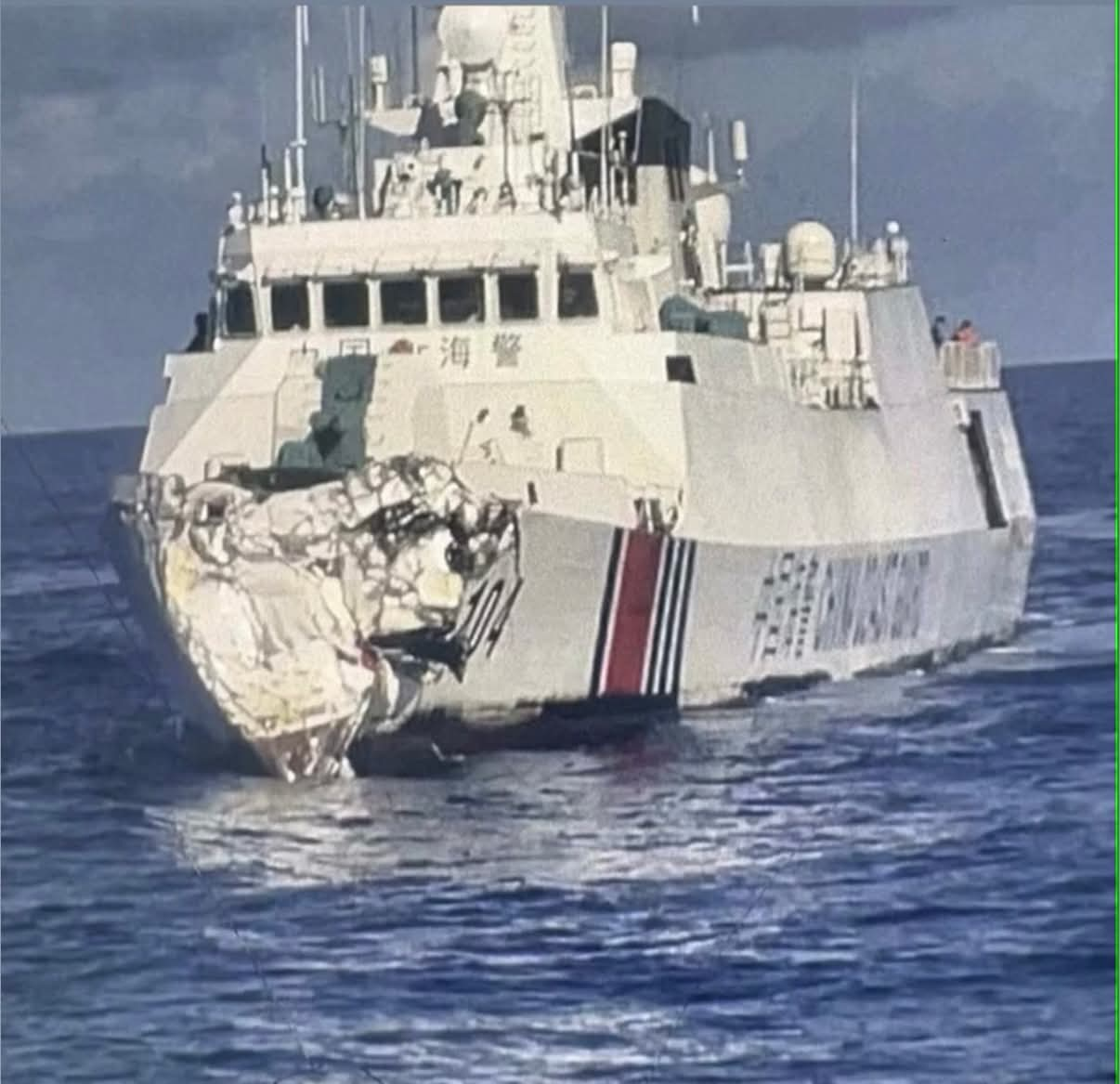China suffered a major embarrassment earlier this month when two of its ships collided in the disputed South China Sea while chasing a smaller Philippine ship. The Chinese Coast Guard (CCG) ship, which was damaged in the collision, has now been confirmed to be undergoing repairs at a major shipyard.
The collision took place near the disputed Scarborough Shoal on August 11, when the two Chinese vessels–the Chinese Coast Guard ship CCG3104 and a People’s Liberation Army Navy (PLAN) Guilin destroyer–ganged up on Philippine Coast Guard (PCG) vessels that were escorting a humanitarian mission to resupply Filipino fishermen.
While the PLAN ship sustained minor damage to its port side, the CCG ship CG3104 suffered significant damage to its bow, as seen in the visuals published in the aftermath of the incident on August 11.
According to an exclusive Reuters report, the ship is now under repair at the Yulin naval base near Sanya, Hainan Island. The publication was provided with satellite imagery by Maxar Technologies.
This is reportedly the first confirmation that the ship has returned to port.
The vessel was seen at the Yulin naval base near Sanya, a city on Hainan with a crushed bow and tugs on either side of the dry dock. The EurAsian Times could not independently verify these claims. However, the Reuters report stated that analysts, including Maxar, expressed confidence that the ship in the photos was the CG3104.
Days After F-16 Upgrade News, Poland’s ‘Aging’ Fighter Crashes During Rehearsal; Claims Pilot’s Life
Notably, Jay Tarriela, spokesperson for the Philippine Coast Guard (PCG), stated on August 27 that the PCG saw the two Chinese ships leave the shoal the day after the incident. However, he added that they were not seen during a flight later that week.
“The Chinese coast guard did not contact the Philippines Coast Guard about any potential casualties or injuries,” Tarriela added.
Online ship trackers noted that CG3104 did not have its transponder on before or after the accident. However, Ray Powell of maritime analysts SeaLight noted in a post on X that another coast guard ship and other Chinese vessels conducted search and rescue operations near the shoal over the next day.
Some observers have noted that the repair work underway at one of the country’s most significant shipyards, which hosts Chinese aircraft carriers, suggests that the damage is very serious.
However, Singapore-based security expert Collin Koh told Reuters that the ship was originally used by the navy as a Type 056 corvette, which explains why it would be repaired at a naval station rather than a coast guard base.
The Big Embarrassment
China is notorious for conducting dangerous maneuvers against the Philippines’ Coast Guard and replenishment ships in the South China Sea. Beijing has sovereignty claims over nearly the entire sea as its sovereign territory and remains marred in territorial disputes with several other claimants in the Southeast Asian region, including the Philippines.
Though China has often conducted dangerous maneuvers to intimidate the Filipino forces operating in the region, this was the first time that a CCG ship sustained heavy damage, whereas the Filipino ship escaped unscathed.
It has since been viewed as a significant blunder for China, as evidenced by the pin-drop silence that has surrounded the incident among its senior officials.
On August 11, 2025, a collision occurred in the South China Sea near Scarborough Shoal involving a China Coast Guard (CCG) cutter and a People’s Liberation Army Navy (PLAN) guided-missile destroyer during an aggressive attempt by Chinese forces to blockade and harass Philippine Coast Guard (PCG) vessels that were escorting a humanitarian mission to resupply Filipino fishermen operating in the Scarborough Shoal region.
PRC vessels collided into each other Aug 11 while conducting dangerous maneuvers near Scarborough Reef. We condemn this latest reckless action by China directed against 🇵🇭 vessel BRP Suluan and commend @coastguardph for their professionalism and their offer to render assistance. pic.twitter.com/SinxO8gRca
— Ambassador MaryKay L. Carlson (@USAmbPH) August 12, 2025
“The (China Coast Guard vessel) CCG 3104, which was chasing the (Filipino coast guard vessel) BRP Suluan at high speed, performed a risky manoeuvre from the (Philippine) vessel’s starboard quarter, leading to the impact with the PLA (People’s Liberation Army) Navy warship,” PCG spokesperson Jay Tarriela said. “This resulted in substantial damage to the CCG vessel’s forecastle, rendering it unseaworthy,” he added.
Without specifically mentioning the incident, Beijing accused the Philippines of “dangerous manoeuvres.” However, Manila’s foreign ministry denied any culpability for the disaster, calling it an “unfortunate outcome.”
The CCG 3104 ship, which has sustained damage, was chasing the Philippine vessel BRP Suluan at high speed. At the same time, the PLAN Guilin (164) destroyer attempted to cut off the Philippine vessel. The two Chinese vessels mis-coordinated, resulting in CCG 3104 ramming into Guilin’s port side.
The CSG ship was likely rendered unseaworthy, as its bow was seen destroyed in photos published by the Philippine side. Some observers said that the CCG 3104’s bow was “smashed like an aluminum can.”
The incident was captured in a dramatic video recorded by the PCG and subsequently published online. According to reports, the Philippine Coast Guard offered man-overboard recovery and medical assistance to the Chinese side via radio, but the offer was ignored.

CCG 3104 was left crippled in the Philippine Exclusive Economic Zone (EEZ), at least for a few hours, before it was dragged to the Yulin shipyard.
The Scarborough Shoal — a triangular chain of reefs and rocks — has been a flashpoint between the countries since China seized it from the Philippines in 2012. On its part, the Philippines Coast Guard (PCG) maintains that the Chinese Coast Guard (CCG) has no legal authority in the area under the Philippine law, UNCLOS, and the 2016 Arbitral Award.
The incident triggered widespread trolling of China and its Coast Guard, which is often seen intimidating and harassing the Philippines’ vessels while asserting dominance over what is legally recognised as Filipino territory. Some netizens and military bloggers joked that “someone is losing their job,” referring to the crew in charge of the two ships.
Meanwhile, the CCG pinned the blame for the collision on the Philippines, stating that it had taken necessary measures, including monitoring, pushing out, and implementing control measures, to drive away the Philippine vessels in accordance with the law.
A Chinese expert was quoted by state-controlled media as saying that the collision between the two Chinese vessels occurred primarily because the Philippine Coast Guard vessel 4406 intruded into China’s territorial waters around Huangyan Dao (also known as Scarborough Shoal) at high speed.
#EXCLUSIVE: The China Coast Guard ship 3104 conducted highly dangerous maneuvers on Philippine Coast Guard 4406 during its illegal patrol in Bajo De Masinloc in the West Philippine Sea on August 11. The video presented by Global Times fails to depict the full context, as it… https://t.co/gRK4ocAsqv
— Jay Tarriela (@jaytaryela) August 14, 2025
These assertions are not rooted in reality, as pointed out by naval and security experts, who allege that China is making excuses to cover up a significant blunder.
Earlier, experts had marked the year 2024 as the “most violent” and “most dangerous moment” for both Beijing and Manila in their protracted South China Sea dispute. For instance, on March 5, 2024, Chinese and Philippine Coast Guard vessels collided near the Second Thomas Shoal, injuring four Filipino crew members.
The Chinese ships blocked Philippine vessels and executed dangerous maneuvers, causing minor collisions at the time.
A few months later, on August 31, 2024, another collision occurred near the Sabina Shoal, with both sides trading blame. The Philippines claimed a Chinese ship intentionally rammed its vessel, while China accused the Philippines of deliberately crashing into their ship.
On December 4, 2024, a confrontation took place around the Scarborough Shoal, with conflicting accounts from both sides. The Philippine Coast Guard reported aggressive actions by Chinese vessels, including the use of water cannons and hazardous maneuvers.
- Contact the author at sakshi.tiwari9555 (at) gmail.com
- Follow EurAsian Times on Google News




